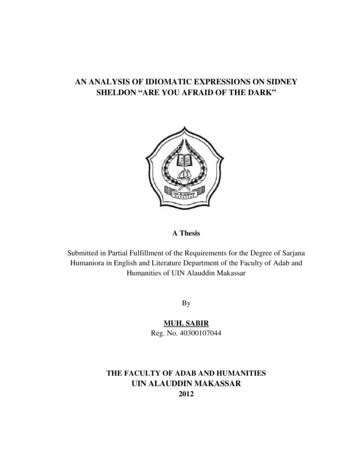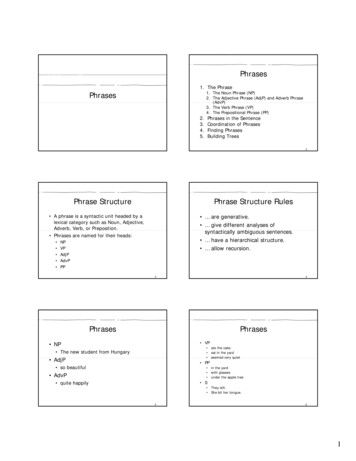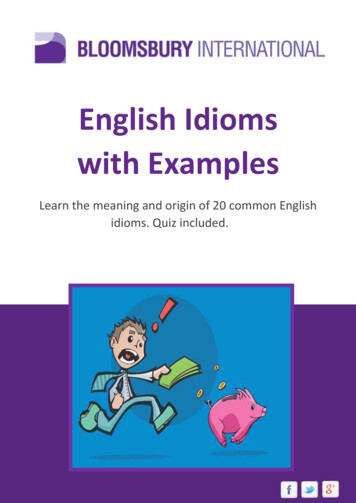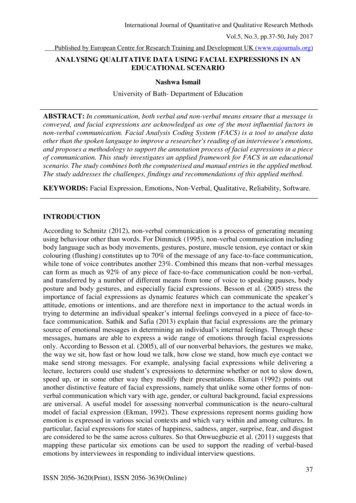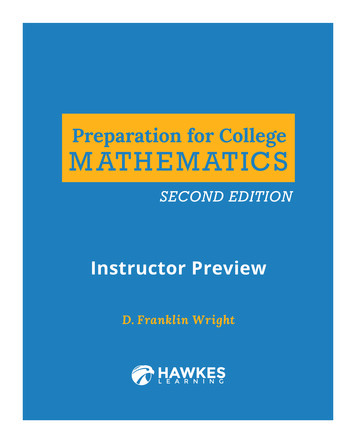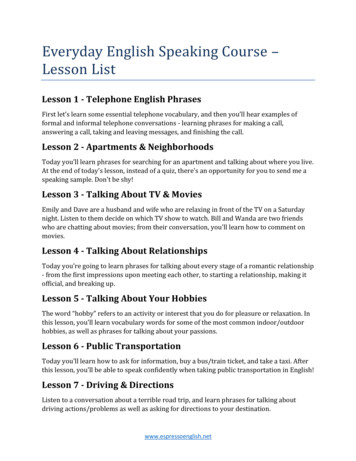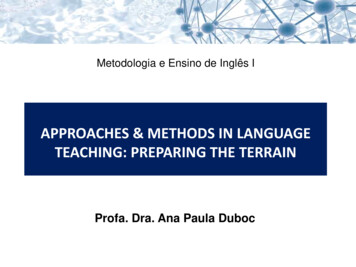
Transcription
Iranian Journal of Language Teaching Research 5(3), (Oct., 2017) 45-59Content list available at http://ijltr.urmia.ac.irIranian JournalofLanguage Teaching ResearchUrmia UniversityTeaching Idiomatic Expressions and Phrases: Insightsand TechniquesEli Hinkel a, *a SeattlePacific University, USABSTRACTCurrently, a relatively large number of spoken and written conventionalized expressions have beencollected, catalogued, and systematized. In language pedagogy, a clear implication is that teachinggrammar and vocabulary is likely to be more complicated than working with syntactic rules and singleword items. Old and new insights associated with the sheer ubiquity of idiomatic constructions canpresent both challenges and opportunities, but it seems vital for teachers to be aware of and becomefamiliar with these language units. This paper takes a look at a few historical perspectives andclassifications of idiomatic phrases and expressions in English, as well as their uses in conversations,speaking, writing, and teaching. To extend this discussion, a few teaching activities and ideas can befurther designed for learning and using idiomatic phrases in the classroom and beyond it. Becausepractically all idiomatic and conventionalized phrases are language and culture-specific, theirinstructional applications can contribute to learners’ strategic fluency development. In general terms,teaching idiomatic language components can lead to improvements in learners’ receptive andproductive skills in various contexts.Keywords: idioms; teaching; speaking; writing; vocabulary Urmia University PressARTICLE HISTORYReceived: 6 June 2017Accepted: 31 Aug. 2017Revised version received: 22 Aug. 2017Available online: 1 Oct. 2017* Corresponding author: Seattle Pacific University, USEmail address: elihinkel@yahoo.com Urmia University Press45
46Eli Hinkel/Teaching idiomastic expressions and Introduction: Idioms and Phraseology in EnglishWhat represents an idiom, a proverb, a conventionalized expression, or a grammatically irregularunit of language is notoriously—famously—difficult to define and hence to identify. Significantand ongoing lexicographic efforts to do so have been undertaken at least since the 1940s. Notsurprisingly, such phrases and expressions can be challenging to explain in teaching, systematizefor making and using learners’ dictionaries, or thematically develop in textbooks. With theemergence of computer technology and the proliferation of large and analyzable language corporain a range of texts and genres, broad expectations arose that the conundrum of defining andidentifying idiomatic and phrasal expressions could potentially be accorded a measure ofsystematicity. However, perhaps counter-intuitively, analyses of language corpora have furtheradded to the typological and terminological stew: computerized examinations of both spoken andwritten language data have shed light on the enormity, variability, and complexity of idiomatic andrecurrent expressions.In the 1970s and 1980s, studies in phraseology and lexicology allowed for far-reaching insightsinto lexicon-grammar interconnectedness (Cowie, 1988; Cowie & Mackin, 1975). Unliketraditional grammars, analyses of idiomatic constructions do not assume that a clear-cut divisionbetween lexicon and grammar exists. All conventionalized expressions and phrases can be assmall as single words or short phrases (e.g., forwards, backwards, silence!, bling, whatever, in the bag, noton your life, a piece of cake) or as long as complete sentences (e.g., a fool and his money are soon parted; youdon’t say; actions speak louder than words; or every cloud has silver lining). Depending on their meaningsand syntactic length, idiomatic phrases can form lexico-grammatical continua that can be treatedas whole-unit structures (Cowie, 1998; Fillmore, Kay, & O’Connor, 1988; Kay & Fillmore 1999;Horwath, 1998).Language research and analyses have long established that a great number of linguisticcombinations simply sound “right” to proficient users of English and that collocations are verycommon in both speaking and writing (Wilkins, 1972; Yorio, 1989). More importantly, however,combinations that are infrequent or hardly ever found may sound unnatural and wrong, evenwhen they are grammatically correct (e.g., ?collect all your chickens in one basket, ?speed down, ?quick food,or ?be upset over spilled milk).A formal and relatively early definition of idioms was advanced by Adam Makkai (1972, p. 23),and was later adopted in several editions of the Oxford English Dictionary in the 1970s and1980s:A form of expression, grammatical construction, phrase, etc., peculiar to a language; a peculiarityof phraseology approved by the usage of language, often having a significance other than itsgrammatical or logical one.In English language textbooks and dictionaries, this classical definition is still widely adopted,although usually not stated. Numerous examples of idioms and phrasal expressions that aretypically provided tend to present them as “peculiarities” and often include such items as to takethe bull by the horns, a hot potato, bring up, get away with, a penny for your thoughts, at the drop of a hat, back tothe drawing board, barking up the wrong tree, beat around the bush, best of both worlds, burn the midnight oil, costan arm and a leg, or can’t judge a book by its cover. In many contexts, learners enjoy English proverbsand sayings due to their oddity and cultural flavor regardless of whether these examples areactually useful in language comprehension or production or whether they are frequent or rare.In examinations of lexicalized phrases and sentences, it has now been established thatconventionalized expressions (e.g., can I come in?, need any help?, what’s for dinner?, call me later, or do
Iranian Journal of Language Teaching Research 5(3), (Oct., 2017) 45-5947not block intersection) are deployed to convey a possibly infinite array of meanings. Anothercomplication is that these language stretches cannot be assembled in the process ofcommunication (Nattinger & DeCarrico, 1994; Pawley & Syder, 1983). A defining characteristicof idioms and formulaic sentence stems is that their meanings and discourse functions cannot bepredicted from the meanings of their components, such as words or parts of words (Hinkel, 2004,2009, 2015).More importantly, the methodological approach to analyzing language and discourse in terms oflexical sentence stems and idiomatic phrases cannot explain the structure and meanings ofconventional and social formulas, idioms, and collocations (sequences of two or more words thatare often used together in speech or writing), e.g., feel free, express bus/train, give an example, give ahand, do homework, break the rules/law, take action, take a chance, take an exam, make adifference/mess/mistake/noise, make an effort, hard left/right, hard rain, heavy coat/sweater/breakfast, or lightsuitcase/meal/ workload). According to some counts, idiomatic phrases, formulaic expressions,collocations, lexical sentence stems, and multiword units number in hundreds of thousands (Shin& Nation, 2008; Stubbs, 2004).For second language (L2) learners, idiomatic phrases and constructions have almost alwayspresented an area of difficulty. For instance, L2 users may misinterpret non-literal meanings ofwords and phrases, as well as misuse them in various contexts—often due to limitations orshortfalls in their L2 vocabulary. In addition, research has demonstrated that most L2 learnersemploy constructions that are error-prone and are hardly ever encountered in English spoken orwritten discourse (Hinkel, 2002, 2003, 2005, 2009). To be sure, in any language, there are probablydifferent ways to say something or convey a thought, but quite often even when the meanings ofphrases can be transparent, “the problem is that native speakers do not say it in that way” (Shin &Nation, 2008, p. 340), for example, *fast wind or *fall into sleep/love, instead of strong wind or fallasleep/in love. In English speech and writing, phrases and expressions are typically culture-specificwith implicit references to abstract or metaphorical constructs that may or may not exist inlearners’ natal cultures or first languages (L1s) (Hinkel, 2014).By and large, phrases, expressions, and collocations are learned by hearing them being usedfrequently enough by other speakers or by reading them in various written texts. Idiomaticstructures are usually encountered in everyday language and acquired in the process ofcommunication, be it oral or written. Specifically, regular, frequent, and common wordcombinations that occur repeatedly can help learners identify and establish linguistic patterns thatcan be then stored and accessed in both language reception and production (Arnon & Snider,2010; Cowie, 1988, 1998).This paper takes a look at a few historical perspectives and classifications of idiomatic phrases andexpressions in English, as well as their uses in conversations, speaking, writing, and teaching. Toextend this discussion, a few teaching activities and ideas can be further designed for learning andusing idiomatic phrases in the classroom and beyond it. Because practically all idiomatic andconventionalized phrases are language and culture-specific, their instructional applications cancontribute to learners’ strategic fluency development. In general terms, teaching idiomaticlanguage components can lead to improvements in learners’ receptive and productive skills invarious contexts.
48Eli Hinkel/Teaching idiomastic expressions and Classifications and DefinitionsAs with practically all complex linguistic phenomena, various types of classifications andorganizing schemes have been devised and debated to account for an extremely large body ofidioms and conventionalized expressions. In the 1920s, Harold Palmer first addressed the utilityof employing ubiquitous phrases and even whole sentences in learning English and developingconversational fluency (Palmer, 1925). According to Palmer’s early findings, one of the fastestways—if not the fastest way—to acquire facility in speaking was to memorize recurrentconversational expressions that could be useful recurrently. For a beginner, Palmer stated,learning to speak in another language required the essential guiding principle: “Memorize perfectlythe largest number of common and useful word groups!” (p. 187).In his subsequent work, Palmer (1933) identified and classified an enormous number ofcommonly occurring lexical phases and phraseological units into content- and function-basedgroups that he called clusters. For the purposes of his pedagogical focus on practical languageteaching and learning, Palmer also coined the term collocation, which, however, did not receivemuch notice until the 1950s. His definition of expressions and collocations for teaching was lateradopted in many works on idiomatic phrases and has remained foundational to this day:“successions of words [that] must or should be learnt . as an integral whole or independententity, rather than by the process of piecing together their component parts” (p. 4).A seminal and groundbreaking work on idiom structure and meanings was further advanced byAdam Makkai (1972). Makkai divides idioms into two major classes: idioms of encoding (orphrasal/leximic idioms) when their meanings are transparent and deducible, and idioms ofdecoding (i.e., semantic idioms, with unpredictable meanings). In this taxonomy, polymorphemic words are categorized as idioms only when at least two free morphemes are present(e.g., free way, sea horse, or car port), thus making the meanings opaque. On the other hand, thewords that consist of free and bound morphemes together are not considered to be idiomaticbecause they require morphological knowledge and rules to decode their meanings, thus maketheir meaning more or less componential and deducible. For example, the meanings of suchwords as pre view, im possible, or bi cycle that include one free and one bound morpheme can bedecoded, even if approximately, based on the meanings of their components. Therefore, thesecannot be classified as idiomatic.One of Makkai’s (1972, p. 120) primary classificatory concerns is whether the compoundmeanings of words and/or their constituents can “potentially mislead” or “misinform” thelanguage user. For instance, in the case of free morpheme compounds, as in hot dog, ball park, orstraw berry, the meanings of the entire words are not deducible. Such frequent and commonlyused idioms and phrases are generally not subject to much variability and are considered to bestable expressions “peculiar to a language” (p. 122). In addition, in Makkai’s classification, manysemantic idioms can be partial or complete sentences with a great number of social and culturalfunctions such as requests (would you/do you mind), warnings (watch your step), invitations (drop by anytime), promises (I swear!), and apologies (so sorry, never again). These are referred to as cultural idiomswith pragmatic meanings.The rigidity of form is a characteristic of only some, but certainly not all, idiomatic expressions. Infact, Cowie and Mackin’s (1975) definition of idioms is probably one of the simplest and mostcomprehensive: “an idiom is a combination of two or more words which function as a unit ofmeaning” (pp. viii-ix). Unlike other definitions, Cowie and Mackin do not consider single-wordentities idiomatic largely because individual words can be identified, taught, and learned asvocabulary items. When it comes to teaching and learning idiomatic expressions, however, thefirst order of priority is to figure out their meanings and then to determine whether they are rigid
Iranian Journal of Language Teaching Research 5(3), (Oct., 2017) 45-5949or flexible in their forms (e.g., take the bull by the horns or see you later/tomorrow/next week/next time).According to Cowie and Mackin, teaching and learning vocabulary extend beyond single words tolonger units of language, from short phrases to complete sentences. To date, dozens of corpusanalyses have largely established that, in fact, most idiomatic expressions and multiword units arevariable in their forms and, to some extent, in their meanings.In idiom classifications, phrasal verbs have a prominent place and have deservedly gained muchattention. First of all, their numbers are so large that their exact or even proximate counts areunknown. The protracted debates of whether these units should be considered idioms, phrases, ormerely extended vocabulary entities have not been resolved, and possibly, will never be(Fernando, 1996; Makkai, 1973; Nation & Webb, 2011). An excellent case in point is that twohighly-regarded and classical dictionaries published by Cambridge University Press and OxfordUniversity Press, since the 1980s and to this day, have chosen to release dictionary compendia ofphrasal verbs as separate volumes to supplement their main dictionaries of English. A key featureof phrasal verb examinations and categorizations is that they have traditionally presented a greatdeal of difficulty for language learners and, by extension, for teachers and material writers (Boers,2000; Boers, Eyckmans, & Stengers, 2007; Boers & Lindstomberg, 2008, 2009).In their pioneering research in the uses of idiomatic phrases, Pawley and Syder (1983) wereamong the first to draw on large computerized databases of real-life language uses. The goal ofthe Pawley and Syder study is to solve what they call the “puzzle of native-speaker fluency” (p.191). The puzzle is that native-speakers can produce and understand language with remarkablefluency and speed in a vast number of contexts and settings without pausing or slowing down.According to these researchers, proficient language users thus demonstrate their “ability toproduce fluent stretches of spontaneous connected discourse; there is a puzzle here in that humancapacities for encoding novel speech in advance or while speaking appear to be severely limited, yetspeakers commonly produce fluent multi-clause utterances which exceed these limits.” Based onthe findings of their studies, Pawley and Syder conclude that “fluent and idiomatic control oflanguage rests to a considerable extent on knowledge of a body of ‘sentence stems’ which are‘institutionalized’ or ‘lexicalized.’” Sentence stems are idiomatic and phraseological units oflanguage in which grammatical form and meaning are largely fixed. The fixed elements in factrepresent culturally or pragmatically recognized idiomatic expressions, concepts, and phrases.Investigative reports on the uses of recurrent and frequent idiomatic phrases and units emerged inforce in the 1990s and 2000s. In this body of research, such units are variously called idioms,idiomatic expressions, collocations, fixed phrases/strings, lexicalized sentence stems, chunks,prefabricated (or prefab) constructions (Cowie, 1988, 1992; Coxhead, 2008; Howarth, 1996,1998). The main reason for the increased attention to these phrases and expressions has to doprimarily with the proliferations of electronic language corpora that have allowed for identifyingand quantifying recurrent combinations of words and phrases that occur in real languageproduction.Although there is probably no single encompassing definition of idioms, idiomatic expressions,collocations, phrases and lexicalized stems typically include: frequently recurring and culture-specific expressions with opaque meanings (e.g., cost an armand a leg; call it a day; better late than never; or in this light ) collocations, that is, words that often occur together but with flexible and variablecomponents (e.g., take place/part/a test/a break; ready to go/start/close [verb]; easy to learn; giveadvice/suggestion(s); at a discount/receive a discount; hard-earned money/hard-won success/victory)
50Eli Hinkel/Teaching idiomastic expressions and fixed phrases with specific and well-defined meanings, as well as phrasal verbs (e.g., breakin/out/down/up/into; in the lurch; out of place; back door; price increase/ decrease; high/low price; a fullplate) figurative expressions (such as metaphors) (e.g., The world is my oyster; couch potato; heart of gold;heart of stone; melting pot; you are my sunshine; the more, the merrier; not on your life; stand out like a sorethumb) conversational routines and pre-patterned speech (e.g., - Excuse me, could you tell me where xxxis?- Up the stairs on your left.- I am sorry I am late. - No problem/No worries.- What a beautiful day! Finally, some sunshine. We’ve had a lot of rain lately.) set and rigidly ordered phrases (in which components are fixed in a certain order) (e.g., herewe go; will that be all?; is there something else? by car/train/bus; by mail; washing machine, table cloth;silver spoon; stay/be out of sight; be at one’s wits’ end; ahead of time; what in the world) proverbs (e.g., two wrongs don’t make a right; the squeaky wheel gets the grease; better late than never; noman is an island) culturally-bound sayings (e.g., a fish out of water; right as rain; count chickens before they hatch; not mycup of tea; the pen is mightier than the sword; Rome wasn’t built in a day)Without question, the definitions of idioms, collocations, and phrasal expressions vary in differentschools of thought. However, the accepted basic concept is that they are multiword units oflanguage—words that are connected to other words—that are remembered and used as singlelexical [vocabulary] items (Peters, 1983).Idiomatic Expressions in Speaking and ConversationsLearning to understand and produce spoken language means being able to understand howlanguage components combine and interact to produce meaning and discourse (Nattinger &DeCarrico, 1992). L2 learners need to become skilled users of vocabulary, phrases, and syntacticconstructions. They need to build their spoken discourse repertoire in order to participate inconversations, formal and casual alike.Participating in conversations requires engaging in a range of complex cognitive and linguistictasks. In social settings, uses of language convey personal views and attitudes, as well as socialvalues and relationships, and communicative goals (Carbaugh, 1989, 2007; Hinkel, 2014; Nation2008, 2009). Conversations are highly structured exchanges that progress along predictable androutine patterns, with participants adapting, adjusting and readjusting, and tailoring what they aresaying—or going to say—depending on the social setting and flow of discourse. In the course ofa conversation, participants’ speech has to remain reasonably grammatically and phoneticallyintelligible, culturally structured and organized (e.g., turn-taking), cohesive, well-paced (e.g.,openings, pauses, and closings), socially and contextually pertinent, and appropriately worded(e.g., politeness) (Carbaugh, 2005; Carter & McCarthy, 1995, 2006; Durrant, 2014).
Iranian Journal of Language Teaching Research 5(3), (Oct., 2017) 45-5951In idiom classifications going as far back as back the 1920s, various sets of recurrent andconventionalized phrases are typically classified by their communicative functions, such asgreetings, requests, apologies, or invitations. Most proficient and fluent language users know thatconversational exchanges are conventionalized and routinized, and they are able to employidiomatic expressions at particular junctures in the speech flow to achieve their communicativegoals (Coulmas, 1981). Spoken routines and idiomatic sequences can be utilized in anextraordinary range of functional contexts and for a practically unlimited variety ofcommunicative and social purposes (Swan, 2006; Ur, 2014). However, in addition to being able todeploy conversational expressions appropriately and in context, language users need to be able tograsp the speaker’s purpose. If the conversational function is not identified correctly, then thecommunicative goal may not be achieved (Cowie, 1992; Fernando, 1996).Based on extensive analyses of social interactions, many analysts have definitively concluded thatit is not just conversational idioms, expressions, and responses to them that are highlyconventionalized, but also, by their very nature, social interactions “employ a number ofstandardized and stereotyped procedures” that mark and characterize them (Nattinger &DeCarrico, 1992, p. 114).A vast body of research on interactional language uses has demonstrated unambiguously thatconversational language and discourse are highly routinized and formulaic. Some studies havefound, for example, that in casual conversations most exchanges are prefabricated and extremelystereotyped (Ajimer, 1996; Coulmas, 1981; Levinson, 1983). For example, in their investigation ofspoken and conversational interactions, Carter and McCarthy (1995, 2006) identified an enormousarray of conversational and pragmatic formulas and phrases that are continually adjusted to suitespecific discourse and social contexts.Numerous research reports have determined that much language acquisition, be it first or second,entails the acquisition of conventionalized expressions and repeated routines. In the short-term,repetition and rehearsal serve to promote the development of longer-term sequence retention andeventual language acquisition (Milton, 1998, 1989; Yorio, 1986). Teaching and learning spokenand conversational sequences and idiomatic formula requires frequent opportunities for repeatedpractice. This is especially true with regard to most phrases and combinations that tend to presentareas of difficulty for learners (e.g., phrasal verbs, make-collocations and get-passives, as in getmarried/it done).Idiomatic and Conventionalized Expressions in WritingIn English, what is appropriate and inappropriate in writing and written discourse is similarlyhighly conventionalized (Swales, 1990). In much language teaching, a great deal of attention, time,and resources are devoted to fostering learners’ facility with various types of writing, andparticularly so academic writing. Typically, academic writing instruction focuses on suchfundamental features of written academic discourse as the idea organization and information flow(e.g., introduction, body, and conclusion), the presence and the placement of the thesis statement,and the structure of the paragraph (e.g., the topic sentence). In research on academic writing,many conventional and highly predictable phrases that mark discourse junctures are called“institutionalized” because they occur more frequently in certain types of texts than in others(Horwath, 1998; Pawley & Syder, 1983; Swales, 1990).
52Eli Hinkel/Teaching idiomastic expressions and In the production of written academic prose, using conventionalized expressions and portions ofsentences is not a language skill that is innate in L1 users and writers. Nor is academic writing auniversal ability that most (or even many) L1 writers come by in the course of their daily life.Learning to write academic texts comes about in the process of schooling and education. Both L1and L2 academic writers have to acquire an extensive repertoire of language skills, such as ideastructuring, grammar, and vocabulary (Cowie, 1988, 1998; Ferris, 2004; James, 1998). It is widelyrecognized in language research and pedagogy that developing academic writing abilities takesmany years—and sometimes longer than a decade (Hinkel, 2002, 2003, 2009, 2011). A vastamount of evidence has shown that L2 academic writers have a great deal of difficulty becomingproficient users of idioms and institutionalized phrases, without which formal written proseprobably cannot be produced (Boers, Eyckmans, & Stengers, 2007; Coxhead, 2008).At present, much is known about idiomatic constructions essential in L1 and L2 academic writing,such as noun phrases (e.g., recent discussions/debates/reports/publications , an importantfact/issue/consideration is , a close/detailed examination/study ) or impersonal it-constructions (e.g., itis well-known/likely/possible/unclear). Additionally, considerable experience has been accumulated inhow to teach various idiomatic sentence stems, conventionalized expressions, “long chunks” oftext (Swales, 1990; Swales & Feak, 2012). These attributes of academic writing need to beexplicitly and persistently taught because they represent requisite (and prescribed) characteristicsof the Anglo-American academic genre (Fernando, 1996; Milton, 1999). For example, eveneducated L2 learners who do not have many opportunities to produce formal English prose maynot be aware of formulaic expressions that usually mark explicit thesis statements, such as thispaper addresses/examines/focuses on or the main points/questions/issues are ).In writing instruction, working with conventionalized written expressions can take the form oftext and paragraph models and examples of paragraphs and essays to demonstrate their idiomaticelements (Hinkel, 2013a). For instance, academic phrases can be useful in instruction on suchdiscourse functions as to express a point of view, support a position, develop an argument, orpresent a research finding. The stereotypical language of academic and other types of writingrepresents a relatively well-covered set of discourse moves and their attendant phrasing (Swales,1990; Widdowson, 2003; Ur, 2011, 2014).When teaching linguistic patterns for L2 writing, teachers may draw on many examples fromspeaking and establish parallels to help learners increase their awareness of frequent phrasaloccurrences. As learners expand their stock of essential expressions expected in L2 writing,writing instruction can co-occur with supplemental work on grammar and vocabulary. Usingstock expressions and short sentences in academic writing is probably one of the most efficientways of expanding L2 writers’ repertoire of word combinations and formulas. Conventionalizedexpressions can be particularly profitable when they include variations of their discrete elementsin flexible constructions. It is safe to say that even advanced L2 learners continue to makegrammar and vocabulary errors in their writing (Ferris, 2004; Ferris & Roberts, 2001; James, 1998;Rifkin & Roberts, 1995). An important advantage of using formulaic expressions in academicwriting is that these units are likely to be more grammatically and lexically accurate than those thathave to be assembled based on a myriad of rules.Idiomatic Expressions and Language TeachingDespite the attention that idiomatic expressions and phrases have received in research, in teachingmaterials, these units of language are still relatively less commonplace than, say, vocabulary andgrammar. Due to their frequency in both spoken and written language, idiomatic formulas and
Iranian Journal of Language Teaching Research 5(3), (Oct., 2017) 45-5953repeated word-combinations can be of great value to learners at practically any level ofproficiency (Aijmer, 1996; Nation & Webb, 2011). One essential feature of expressions andphrases is that they include more than one word or a meaningful unit, and for this reason alone,they require more work and practice. Over time, however, explicit teaching can help learners toaddress matters of lexical retention and to expand their language repertoire. As Nattinger andDecarrico (1992) state,it is our ability to use lexical phrases that helps us to speak with fluency. This prefabricatedspeech has both the advantages of more efficient retrieval and of permitting speakers (andlearners) to direct their attention to the larger structure of the discourse, rather than keeping itnarrowly focused on individual words as they are produced. (p. 32)Numerous idiomatic phrases can be accessible to beginning or intermediate learners. As has beenmentioned, most idioms and conventionalized phrases have non-compositional meanings thatcannot be derived from those of their constituent parts (Boers, 2000; Boers & Lindstromberg,2009; Boers, Lindstromberg, & Eyckmans, 2014). However, frequent a
phrases can be transparent, “the problem is that native speakers do not say it in that way” (Shin & Nation, 2008, p. 340), for example, *fast wind or *fall into sleep/love, instead of strong wind or fall asleep/in love. In E
